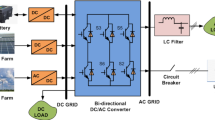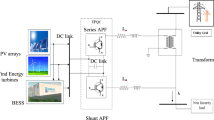Abstract
A two-step methodology was used to address and improve the power quality concerns for the PV-integrated microgrid system. First, partial shading was included to deal with the real-time issues. The Improved Jelly Fish Algorithm integrated Perturb and Obserb (IJFA-PO) has been proposed to track the Global Maximum Power Point (GMPP). Second, the main unit-powered via DC–AC converter is synchronised with the grid. To cope with the wide voltage variation and harmonic mitigation, an auxiliary unit undergoes a novel series compensation technique. Out of various switching approaches, IJFA-based Selective Harmonic Elimination (SHE) in 120° conduction gives the optimal solution. Three switching angles were obtained using IJFA, whose performance was equivalent to that of nine switching angles. Thus, the system is efficient with minimised higher-order harmonics and lower switching losses. The proposed system outperformed in terms of efficiency, metaheuristics, and convergence. The Total Harmonic Distortion (THD) obtained was 1.32%, which is within the IEEE 1547 and IEC tolerable limits. The model was developed in MATLAB/Simulink 2016b and verified with an experimental prototype of grid-synchronised PV capacity of 260 W tested under various loading conditions. The present model is reliable and features a simple controller that provides more convenient and adequate performance.














Similar content being viewed by others
Availability of data and materials
The datasets supporting the conclusions of this article are included within the article and the values of the setup has been included under.
Simulation Data
PV array data: Isc = 8.83 A, Voc = 36.8 V, Impp = 8.3 A, Vmpp = 30 V, Boost converter data: Boost inductor = 2.14 mH, switching frequency (fs) = 10 kHz, DC-bus capacitor (CDC) = 4700 μF.
Experimental Data
Voc = 37.75 V, Isc = 16 A, DC-bus capacitor (CDC) = 2200 μF, Microcontroller switching frequency (fs) = 20 kHz.
References
Choudhary, P., & Srivastava, R. K. (2019). Sustainability perspectives—A review for solar photovoltaic trends and growth opportunities. Journal of Cleaner Production, 227, 589–612.
Alsumiri, M. (2019). Residual incremental conductance based nonparametric MPPT control for solar photovoltaic energy conversion system. IEEE Access, 7, 87901–87906.
Sarvi, M., & Azadian, A. (2021). A comprehensive review and classified comparison of MPPT algorithms in PV systems. Energy Systems, 13, 281–320. https://doi.org/10.1007/s12667-021-00427-x.
Mirza, A. F., Mansoor, M., Zhan, K., & Ling, Q. (2021). High-efficiency swarm intelligent maximum power point tracking control techniques for varying temperature and irradiance. Energy, 228, 120602.
Hassan, A. Y., Ismaeel, A. A., Said, M., Ghoniem, R. M., Deb, S., & Elsayed, A. G. (2022). Evaluation of weighted mean of vectors algorithm for identification of solar cell parameters. Processes, 10(6), 1072.
Chakraborty, S., Saha, A. K., Chakraborty, R., & Saha, M. (2021). An enhanced whale optimization algorithm for large scale optimization problems. Knowledge-Based Systems, 233, 107543.
Eltamaly, A. M., & Farh, H. M. (2019). Dynamic global maximum power point tracking of the PV systems under variant partial shading using hybrid GWO-FLC. Solar Energy, 177, 306–316.
Tu, J., Chen, H., Wang, M., & Gandomi, A. H. (2021). The colony predation algorithm. Journal of Bionic Engineering, 18(3), 674–710.
Zhang, Y. Y., Ma, M., & Jin, Z. G. (2020). Comprehensive learning Jaya algorithm for parameter extraction of photovoltaic models. Energy, 211, 118644.
Abdel-Basset, M., Mohamed, R., Chakrabortty, R. K., Ryan, M. J., & El-Fergany, A. (2021). An improved artificial jellyfish search optimizer for parameter identification of photovoltaic models. Energies, 14(7), 1867.
Chou, J. S., & Truong, D. N. (2021). A novel metaheuristic optimizer inspired by behavior of jellyfish in ocean. Applied Mathematics and Computation, 389, 125535.
Santhoshi, B. K., Mohanasundaram, K., Kaliappan, V. K., & Sathyamurthy, R. (2022). Sinusoidal pulse width modulation for a photovoltaic-based single-stage inverter. Environmental Science and Pollution Research, 29(20), 29830–29840.
Sarker, K., Chatterjee, D., & Goswami, S. K. (2018). Modified harmonic minimisation technique for doubly fed induction generators with solar-wind hybrid system using biogeography-based optimisation. IET Power Electronics, 11(10), 1640–1651.
Sujatha, B. G., & Anitha, G. S. (2018). Enhancement of PQ in grid connected PV system using hybrid technique. Ain Shams Engineering Journal, 9(4), 869–881.
Peraza-Vázquez, H., Peña-Delgado, A., Ranjan, P., Barde, C., Choubey, A., & Morales-Cepeda, A. B. (2021). A bio-inspired method for mathematical optimization inspired by arachnida salticidade. Mathematics, 10(1), 102.
Al-Hitmi, M., Ahmad, S., Iqbal, A., Padmanaban, S., & Ashraf, I. (2018). Selective harmonic elimination in a wide modulation range using modified Newton–Raphson and pattern generation methods for a multilevel inverter. Energies, 11(2), 458.
Ning, L., Tong, G., Hui, Z., & Ping, Y. (2019). Comparative research of harmonic suppression algorithm of the three-level NPC converter. The Journal of Engineering, 16, 1271–1274.
Ramesh, A., & Sait, H. H. (2020). An approach towards selective harmonic elimination switching pattern of cascade switched capacitor twenty nine-level inverter using artificial bee colony algorithm. Microprocessors and Microsystems, 79, 103292.
Nalcaci, G., Yildirim, D., & Ermis, M. Selective harmonic elimination for light-rail transportation motor drives using Harris hawk’s algorithm. In 2020 IEEE International Conference on Environment and Electrical Engineering and 2020 IEEE Industrial and Commercial Power Systems Europe (EEEIC/I&CPS Europe), Madrid, Spain, 2020, 1–6.
Memon, M. A., Mekhilef, S., Mubin, M., & Aamir, M. (2018). Selective harmonic elimination in inverters using bio-inspired intelligent algorithms for renewable energy conversion applications: A review. Renewable and Sustainable Energy Reviews, 82, 2235–2253.
Cleveland, F.M. (2008). IEC 61850-7-420 communications standard for distributed energy resources (DER). In 2008 IEEE Power and Energy Society General Meeting-Conversion and Delivery of Electrical Energy in the 21st Century, Pittsburgh, Pennsylvania, USA, 2008, 1-4
Blooming, T. M., & Carnovale, D. J. (2006). Application of IEEE Std 519-1992 harmonic limits. In Conference Record of 2006 Annual Pulp and Paper Industry Technical Conference, Appleton, Wisconsin, USA, 2006, 1-9.
Basso, T. (2014). IEEE 1547 and 2030 standards for distributed energy resources interconnection and interoperability with the electricity grid (No. NREL/TP-5D00–63157), National Renewable Energy Lab. (NREL), Golden, CO (United States), 2014.
Beaulieu, G., Bollen, M. H., Malgarotti, S., & Ball, R. (2002). Power quality indices and objectives. Ongoing activities in CIGRE WG 36–07. In IEEE Power Engineering Society Summer Meeting, National Renewable Energy Lab. (NREL), Golden, CO (United States), 2002, 2, 789–794.
Chatterjee, D. (2011). A novel magnetizing-curve identification and computer storage technique for induction machines suitable for online application. IEEE Transactions on Industrial Electronics, 58(12), 5336–5343.
Author information
Authors and Affiliations
Corresponding author
Ethics declarations
Conflicts of interest
None.
Ethical Approval
The manuscript is an original research work. This has neither been published previously, nor under consideration for publication elsewhere.
Informed Consent
Approved.
Additional information
Publisher's Note
Springer Nature remains neutral with regard to jurisdictional claims in published maps and institutional affiliations.
Rights and permissions
Springer Nature or its licensor holds exclusive rights to this article under a publishing agreement with the author(s) or other rightsholder(s); author self-archiving of the accepted manuscript version of this article is solely governed by the terms of such publishing agreement and applicable law.
About this article
Cite this article
Suman, S., Chatterjee, D. & Mohanty, R. A Novel Approach for Mitigating Power Quality Issues in a PV Integrated Microgrid System Using an Improved Jelly Fish Algorithm. J Bionic Eng 20, 30–46 (2023). https://doi.org/10.1007/s42235-022-00252-7
Received:
Revised:
Accepted:
Published:
Issue Date:
DOI: https://doi.org/10.1007/s42235-022-00252-7




